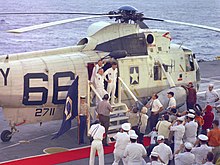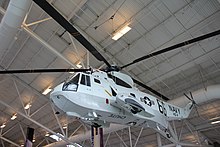Helicopter 66

Helicopter 66 was the popular name for a Sikorsky Sea King - Helicopter of the US Navy , during the underwater recovery of the astronauts of the Apollo program was used. Due to frequent media reports, he also achieved great public awareness. The military helicopter crashed during an exercise in the Pacific Ocean in 1975 .
Sikorsky SH-3D
Helicopter 66 was a Sikorsky SH-3D designed for submarine hunting and typically designed for four crew members and three passengers. Powered by two General Electric T58-GE-10 shaft engines with 1400 PS (1000 kW) each, SH-3Ds had a top speed of 120 knots (220 km / h; 140 mph) and a maximum flight time of an average of 4.5 hours . They had a maximum allowable weight of 20,500 pounds (9300 kg) with the ability to carry an external towing load of up to 6000 pounds (2700 kg). During anti-submarine missions, the SH-3D was usually armed with MK-46/44 torpedoes.
Mission history
Helicopter 66 was used during its entire service life in the Helicopter Anti-Submarine Squadron FOUR (HS-4) set up on June 30, 1952 . The unit, nicknamed the Black Knights, was the first US Navy anti-submarine helicopter squadron to be deployed on board an aircraft carrier; so in 1953 on board the USS Rendova .
Helicopter 66 entered service with the US Navy on March 4, 1967 and was assigned to the HS-4 squadron in 1968. He carried the Bureau Number 152711 and his US Navy Modex was initially NU-66. HS-4 was then part of the Carrier Antisubmarine Group 55 (CVSG-55), which was stationed on the USS Yorktown . The Modex numbers of HS-4 ranged from 50 to 66. NU was the group identifier and the Modex number uniquely identified each aircraft on the carrier. In 1968 Yorktown and Squadron Four were commissioned to support NASA and rescue the returning astronauts from Apollo 8 .
After the dissolution of the CVSG-55, Helicopter 66 was assigned to the CVSG-59 and carried the Modex NT-66 there. The group was initially stationed on the USS Bennington before being transferred to the USS Hornet in June 1969 . Helicopter 66 remained the only HS-4 machine there that had a Modex number with the 66 outside of the originally allocated range from 300. In May and July 1969 she took part in the rescue of Apollo 10 and Apollo 11 . The rescue of Apollo 10 was carried out by Helicopter 66 as part of a delegation from the USS Princeton .

During the Apollo missions Apollo 8, Apollo 10 to Apollo 13, Helicopter 66 was the primary rescue helicopter that carried returning astronauts out of the spacecraft command capsule, and achieved media notoriety.
| mission | Flight date | Baseship | pilot | proof |
|---|---|---|---|---|
| Apollo 8 | December 27, 1968 | USS Yorktown (CV-10) | Donald S. Jones | |
| Apollo 10 | May 29, 1969 | USS Princeton (CV-37) | Chuck B. Smiley | |
| Apollo 11 | July 24, 1969 | USS Hornet (CV-12) | Donald S. Jones | |
| Apollo 12 | November 24, 1969 | USS Hornet (CV-12) | Warren E. Aut | |
| Apollo 13 | April 17, 1970 | USS Iwo Jima (LPH-2) | Chuck B. Smiley |
Markings
From April or June 1969 the Modex of HS-4 on the USS Hornet actually began at NT-300, but the helicopter continued to use its original identifier 66 until it left the Hornet in February 1970. After it was moved to the Ticonderoga from October 1970 to July 1971 began assigned numbering for HS-4 at NT-400. From November 1973 after the transfer to the carrier squadron CVW-11 and transfer to the USS Kitty Hawk , the machine carried the identification NH-740. It cannot be proven whether the helicopter actually received the 66 mark temporarily after 1970.
During the period in which it was used for astronaut recovery, Helicopter 66 wore a space capsule silhouette on its fuselage for each recovery it participated in. For the rescue of the astronauts of Apollo 11, the underside of the fuselage was painted with the words "Hail, Columbia".
crash
At 7:00 p.m. on June 4, 1975, Helicopter 66, renumbered Helicopter 740, was en route from Naval Outlying Landing Field Imperial Beach, near San Diego , California to U.S. Navy's Helo Offshore Training Area for a scheduled three hour nightly Conduct anti-submarine exercise. During the process, the helicopter and the crew of four crashed. Although the crew was subsequently rescued by the US Coast Guard, the pilot Leo Rolek succumbed to his injuries and later died. The exact cause of the Helicopter 66 accident is unknown; the US Navy incident report has remained secret since 2017. The broken fuselage of the helicopter sank to 800 fathoms (1500 m). At the time of the crash, Helicopter 66 had had 3,245.2 flight hours since the start of duty and 183.6 hours since the last overhaul .
The sunken helicopter remains the property of the US Navy; the endeavor of private individuals to recover the wreck in 2004 was not realized.
Reception, reminder
The helicopter 66 has been depicted many times by the news agencies and, in the words of the space historian Dwayne A. Day, achieved "the rank of one of the most famous or even most iconic helicopters in history".
Replicas
Replicas are on display at the USS Hornet Museum and the USS Midway Museum. The helicopter in the USS Hornet Museum is an out-of-service Navy Sikorsky Sea King painted with Helicopter 66, which was used in the film Apollo 13 . A Sikorsky Sea King painted in Helicopter 66 edition is also on display by the National Museum of Naval Aviation.
During the early 1970s, Dinky Toys released a Helicopter 66 edition die-cast toy model of a Sea King helicopter. The model had a working winch that could lift a toy space capsule.
Artistic arrangements
A painting of the Helicopter 66 was commissioned by artist Tom O'Hara in 1969 as part of a NASA art initiative. It then came into the possession of the National Air and Space Museum.
In September 1969 singer Manuela released the single "Helicopter US Navy 66", which included the sound of the helicopter rotors. The song was covered the following year by Belgian pop singer Samantha. In a 2007 interview, the popularity of “Helicopter US Navy 66” as the final song in a disco in Belgium in 1970 was named as the inspiration for the Belgian pop singer Laura Lynn for the hit “Goud”.
Trivia
In 1973 the Helicopter Squadron Four was stationed with Helicopter 66 on the USS Kitty Hawk in the Indian Ocean. The helicopter transported the Shah of Iran Mohammad Reza Pahlavi to the aircraft carrier for a ship inspection.
Web links
Individual evidence
- ^ H-3 Sea King . Federation of American Scientists . Retrieved February 7, 2018.
- ↑ S-61 . Igor I. Sikorsky Historical Archives.
- ↑ Overview of helicopters used to rescue space capsules
- ↑ CVSG-55 at www.gonavy.jp
- ↑ Milt Putnam: Navy Photographer Tells the Story of Apollo 11 Recovery . Naval Historical Foundation. Retrieved November 3, 2017.
- ↑ Helicopter 66 crash . Retrieved August 14, 2018.
- ↑ Squadrons of the CVW-11
- ^ Helicopter Unit Changes Command . In: Chula Vista Star-News , newspapers.com , September 26, 1971, p. 20. Retrieved February 7, 2018. (subscription required)
- ^ The Final Flight .
- ↑ It's time to recover Helo 66 . In: The Space Review , September 17, 2017. Retrieved November 3, 2017.
- ^ Aircraft Accident Report . United States Navy aircraft mishap board . Pp. 1-4. Retrieved February 7, 2018.
- ↑ Don Blair: Splashdown !: NASA and the Navy . Turner Publishing Company, 2004, ISBN 978-1-56311-985-9 , p. 43.
- ↑ The last flight of Helo 66 . In: The Space Review , June 25, 2007. Retrieved November 3, 2017.
- ↑ Helo 66 revisited . In: The Space Review , July 9, 2007. Retrieved November 3, 2017.
- ^ Artifact Pick of the Week . Evergreen Aviation & Space Museum . Retrieved February 7, 2018.
- ^ A b Dinky Toys News Space Recovery Special . In: Meccano Magazine , June 1971, p. 274. Retrieved February 7, 2018.
- ↑ a b Recovery Helicopter # 66 . Smithsonian Institution . Retrieved November 3, 2017.
- ↑ Manuela - Helicopter US Navy 66 (song) . Federal Association of the Music Industry . Retrieved February 8, 2018.
- ↑ Hoe zou het zijn met Samantha? (nl) , radio 2 . June 24, 2016. Retrieved February 11, 2018.
- ↑ Home Muziek Radio & Televisie Musical & Theater Film Photo albums Calendar Wedstrijden "Goud" nieuwe album from Laura Lynn! (nl) . In: Front View Magazine , June 7, 2007. Retrieved February 11, 2018.
- ↑ Kitty Hawk II (CVA-63) . US Navy . Retrieved February 7, 2018.

